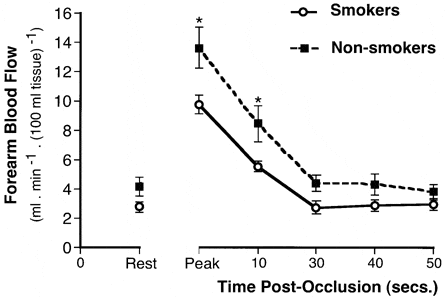Endothelial dysfunction, an important event in early atherogenesis, has been described in the conduit arteries of chronic smokers (Celermajer et al. 1993) but it is unclear whether smoking also affects endothelial function in resistance vessels (Rangemark & Wennmalm, 1992; McVeigh et al. 1996). In this study, we have compared functional and non-functional markers of endothelial viability in the resistance vessels of young, healthy male smokers and non-smokers. Statistical analysis was performed using Welch’s t test and data are expressed as means ± S.E.M. With ethical approval, 32 healthy, normotensive men (aged 18-30 years) were recruited from the student body at Trinity College Dublin. Of these, eleven were smokers, having consumed a minimum of 10 cigarettes day-1 (14 ± 1 cigs day-1) for at least 1 year. These subjects were allowed free access to cigarettes throughout the study. The remaining 21 recruits were long-term non-smokers. All subjects underwent an initial maximal fitness test and a medical examination during which a blood sample was drawn for the quantification of circulating endothelial cells (CECs). Smokers and non-smokers did not differ in either body mass index (22.7 ± 0.7 cf. 22.9 ± 0.5 kg m-2) or physical fitness (VO2,peak 51.2 ± 2.7 cf. 52.2 ± 2.3 ml min-1 kg-1). In ten smokers and 16 non-smokers, forearm blood flow was measured by venous occlusion plethysmography at rest and during reactive hyperaemia, following brachial arterial compression for 3 min. Reactive hyperaemia is predominantly due to local release of endothelium-derived nitric oxide and can therefore be used as an index of endothelial function (Joannides et al. 1995). CEC numbers were significantly higher in smokers than in non-smokers (133.6 ± 22.8 cf. 80 ± 9.6 cells ml-1, P < 0.05). Although resting forearm blood flows were not significantly different (2.8 ± 0.4 cf. 4.1 ± 0.7 ml min-1 (100 ml tissue)-1), the magnitude of hyperaemia was significantly lower in smokers than in non-smokers (peak flow, 9.7 ± 0.7 cf. 13.6 ± 1.4 ml min-1 (100 ml tissue)-1, P < 0.05) (Fig. 1). The half-recovery times were similar for both groups (9.2 ± 1.1 cf. 9.3 ± 0.7 s). These results indicate that moderate smoking induces endothelial dysfunction in the resistance vessels of young, healthy men.
This work was supported by Enterprise Ireland.

